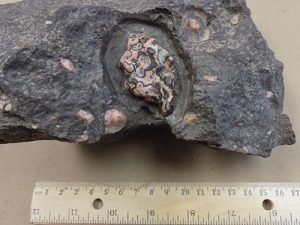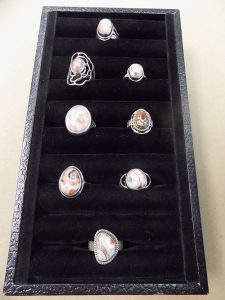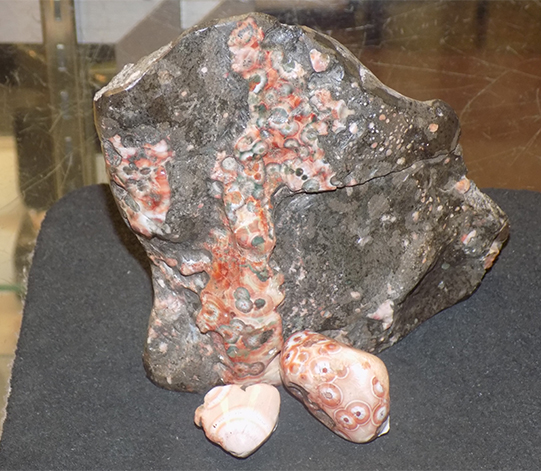
Story by Mark Leatherman
Some of my favorite gemmy specimens in my collection are those that contain multiple colors in the same piece, such as Chinese rainbow fluorite, and watermelon tourmaline. Others might say that these minerals contend for the title of the world’s most colorful gemstone. However, it was not long ago that I found out about a much rarer mineral that could give the above two a big run for their money: Minnesota’s version of the zeolite mineral, thomsonite (also known as lintonite). Its rarity is due to the fact that this gem variety is only found on a six-mile stretch of “North Shore” beach.
Analyzing Thomsonite
Thomsonite was named after Thomas Thomson, a Scottish chemist, in 1840. It is said that he first found, and subsequently analyzed, the mineral in a former county in west-central Scotland called Dumbaronshire (considered to be its true type locality). The Scottish thomsonites typically occur in white to pale pink hues in radiating prisms, and are hosted in a series of basalt lava flows called the Clyde Plateau that are 340 million years old.
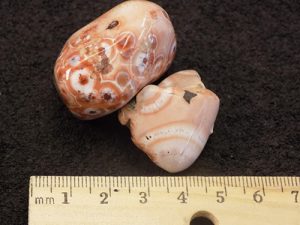
Newton Winchell, the first Minnesota state geologist (1872-1900), conducted regular geologic surveys with two of his graduate students, C.W. Hall and S.F. Peckman, in the northern part of the state. It is said that the students were the first to discover the small, colorful mineral embedded in the basalt flows along the Lake Superior shore. The first documented report of the zeolite was published in 1888.
However, it was not until the 1920s, after the completion of the North Shore highway (state Route 61), that the thomsonite locality became more widely known—not to mention accessible!
Minnesota Version of Thomsonite
In 1962, the landmark Thomsonite Beach Motel and Jewelry Shop, now the Thomsonite Beach Inn & Suites, opened six miles south of the town of Grand Marais, Minnesota, on Route 61, near a gem-mining operation. Tania and Maurice Feigal, the original owners, were passionate rockhounds and lapidary masters. They started the continuing tradition of making and selling gold and silver thomsonite jewelry, along with offering rooms. The Feigals sold the property in 1998. Current owners Lee and Scott Bergstrom say that, were it not for the Fiegals, thomsonite may not have been as popular as it is in the area today.
I first heard of thomsonite—the mineral in general, not just this gemmy version—when I was living in the town of Ely, Minnesota. A work friend and I decided to make a stroll down to the beaches of Beaver Bay to hunt for the famous Lake Superior agates. We spotted the Beaver Bay Agate Shop along the main drag (Route 61), and decided to peek inside after we were done hunting.
Of course, the first thing I noticed in the shop were “Laker” agate specimens that made us quite envious, as our hunt did not turn up much. Upon further browsing, my eyes set on thomsonite gems for the first time. Shop owners Keith and Teresa Bartel were happy to regale me with stories of their experiences with the gem.
Keith had first read of the unique zeolite around 35 years ago in an old book. Noting that it was quite the rarity, he took a trip up to the Grand Marais-area beach. He has been enthralled with the stone ever since, and decided to make it a central part of the shop, which has been in business since 1946. The Bartels have accumulated thousands of thomsonite specimens in their personal collection, along with a considerable amount of other Lake Superior-area gems. Before leaving the shop, I had to make sure that I found out where to find this fascinating gem. That was when I found out that a small stretch of beach at the Thomsonite Beach Inn was pretty much the sole source.
Formed During a Rifting Event
The colorful Minnesotan version of this zeolite was born out of a massive continental rifting event that started over 2 billion years ago. Back in the Proterozoic Era, the interior of the ancient North American Plate began to split apart due to magma erupting from a long, boomerang-shaped fissure. As the crack widened, massive outpourings of runny basaltic lava flooded the land. The resulting rock became the foundation for the Great Lakes, formed some of the most wonderful geology around, and produced several types of ore deposits and unique gemstones.
Before the split was complete, it suddenly failed. Although the tectonic
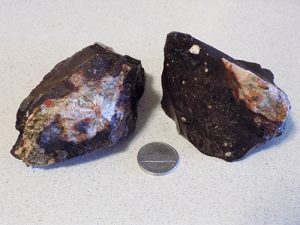
extension ceased, hydrothermal fluids circulated through the basalt leaching, iron and other elements from it. The dissolved elements precipitated out into the gas voids (vesicles) left behind by the degassed, cooling molten basalt. Along with thomsonite, other notable minerals found in vesicles along the North Shore are prehnite, calcite, and the Lake Superior agate.
Thomsonite crystals grow within the vesicles as vertical, needlelike bunches from a central “seed”, and proceed to grow outward. Faint, fibrous patterns can be observed in many of the stones. The fibrous habit, combined with multiple colors, gives rise to another defining characteristic of thomsonite: its concentric “eyes”.
The best thomsonite gems contain multiple eyes, formed around multiple “growth seeds”, that can stand alone or grow into each other, much like cave stalactites.
As in many other gems, different trace impurities give rise to different hues. It is thought that shades of pink are caused by varying quantities of free Fe+2 ions, leached from the surrounding basalt, whereas the cause of shades of green is believed to be inclusions of iron silicate minerals. A few gems even contain very small bits of native copper, which is not surprising given that Michigan’s nearby native copper deposits are hosted by (mainly) the same basalts. It would also not come as a surprise if free Cu+2 ions play a role in some coloration.
Zeolite Family
Chemically, thomsonite (NaCa2Al5Si5O20•6H2O) belongs to the zeolite family of silicate minerals. Zeolites are used as molecular sieves and water softeners due to their open, tunnellike atomic structure. Like quartz, zeolites are framework silicates; however, the basic silica units are spread farther apart, making them able to accommodate metals like sodium and calcium, which are rather large in atomic size.
Most commercial quantities of zeolites occur in hydrothermally altered beds of tuff and in saline lake deposits, rather than amygdules. There are two subtypes of thomsonite, depending on the dominant alkaline earth metal present. As the formula may suggest, far and away the most dominant type is thomsonite-Ca, with calcium being essential to its crystal structure. The rarest variety of the gem is thomsonite-Sr (strontium), the most noted source of which is in the Aldan Shield in the Eastern Siberian region. While thomsonite is easily attractive enough to be used as a gemstone, it has only a moderate Mohs hardness of 5-5.5.
The typical colors of thomsonites from other localities, such as from Table Mountain, Colorado (January 2016 Rock & Gem), are white, beige, pale yellow-cream, light grey, and pale orange, although most specimens display one or two hues. What really sets Minnesota thomsonite apart is the wide variety of hues and color combinations. Along with the above colors, a variety of pink and green hues make their distinctive mark. It has been reported that up to 172 color and hue combinations have been observed in this material. I learned from Lee Bergstrom that an even more specific area produces thomsonite with black areas in it!
Another defining characteristic of Minnesota thomsonite is its quite small average size. The vesicles in which the gems form are, on average, only several millimeters across. I have collected only a very few matrix pieces in which mineralized vugs have hit the 1 cm mark in diameter. Two years back, when I was starting to make some simple jewelry of my own on a budget, I received a small bag of tumbled stones in which the largest pieces were only the size of a pea. It turns out that most or the loose stones found on the lakeshore at Thomsonite Beach Inn are not much bigger than that.
Scale-Tipping Thomsonite
Talk about needing a sharp set of eyes! Keith informed me that the largest thomsonite he has ever found weighs in at a whopping 2.5 pounds, and measures just under 4 inches! He did not say where or when he found it, and one can certainly not blame him for keeping such a golden secret. As far as I know, Keith currently owns the ultimate whopper in thomsonite.
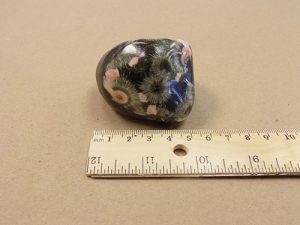
As a stone that is rarer than diamonds, rubies, emeralds or sapphires, thomsonite’s value in the Great Lakes area is quite noteworthy. In an average year, the Beaver Bay Agate Shop sells more than a thousand pieces of thomsonite jewelry each year.
In addition, it is a prime place for people to have their own finds custom set into jewelry. When it comes to loose gems, however, Keith says that whenever he does get any in stock, they are gone in a flash. He cited that last year, during which he received a total of 7 gallons of loose nuggets, every time an individual shipment came in, the entire contents would be gone in only a couple days! The typical value range of these thomsonites is anywhere from $5 to $20 per gram, according to Keith.
The three main factors that account for the price of this gem are linear fractures, “eyes”, and greenish hues. For instance, a gem that has no fractures, some eyes, and shades of mostly pink and cream will only be worth around half as much as a stone with all these same, as well as a healthy amount of green coloration (typically light and “forest” shades). A bluish-green tint is even rarer. For those who are into matrix pieces with basalt, the average price range is around $5 to $10 per pound.
Extraction Methods
Given its relatively low hardness, extracting thomsonite intact from its hard basalt host requires quite a bit of skill and practice. Keith says he often uses a three-fold extraction method: First, when working on bulk matrix material, he uses a diamond saw to cut down the amount of matrix area. Second, he uses a rotary tool to remove host basalt near the gems, exposing a little more of their surface area.
Third, he uses some very fine chisels, sharpened like a pencil, and carefully pries out the stones. Although the process seems rather straightforward, Terry assures that it is easier said than done for most beginners.
Fortunately, once loose gems are acquired, they take a great polish from cerium oxide grit. The recommended polishing phase utilizes a wide range of grit sizes, starting at 220 grit and finishing with 3000 grit.
At the Thomsonite Beach Inn, only guests have access to the immediate adjoining beach. Although this private stretch of beach is in the middle of the best concentrations of loose stones, the owners discourage picking in order to preserve the beauty of the area. The Bergstroms will, however, point you in the direction of promising picking spots. In addition, the inn sells both thomsonite jewelry (most in sterling silver) and loose stones in a wide variety of price ranges. Custom work is available on request.
Accommodations For Thomsonite Digging Excursions
If one does not want to stay overnight, there is a road pullout, called the Good Harbor Bay Overlook, right after the inn as Route 61 bends northward. Right across the road is a distinct section of tilted, older, dark-red sedimentary rocks that contains ripple mark structures that are overlain by black basalt (47°43’34.1”N, 90°26’35.1”W). When I visited, there were plenty of basalt boulders on the ground, and most contained an array of intact zeolites. Furthermore, parts of the outcrop were fractured enough that I could extract some in situ matrix pieces without the need for hand tools.
Additionally, only a third-mile farther up the highway, where it bends
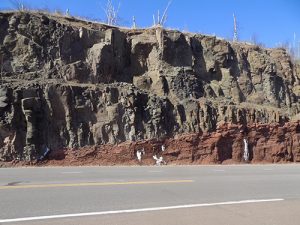
again eastward, is the Next to the parking lot is a stairway right to public beach land. While visiting there, the only thomsonites I found were firmly in the basalt that made up the beach wall. I believed that I had better luck at the outcrop than at the beach!
Although opaque, thomsonite is a feast for the eyes, with its multiple colors and patterns. It is a billion-year-old gem whose beauty has stood the test of time. Even a small specimen would make quite an addition to any collection, with its color combinations rivaling those of the best “rainbow” mineral specimens.
The Beaver Bay Agate Shop is located at 1003 Main St., in Beaver Bay, Minnesota (www.beaverbayagateshop.com). Contact owners Keith and Teresa Bartel at (218) 226-4847 or beaverbayagate@lakenet.com.
Thomsonite Beach Inn & Suites is located at 2920 W. Hwy. 61, Grand Marais, Minnesota (www.thomsonite.com). Contact owners Lee and Scott Bergstrom at (888) 387-1532 or (218) 387-1532.


